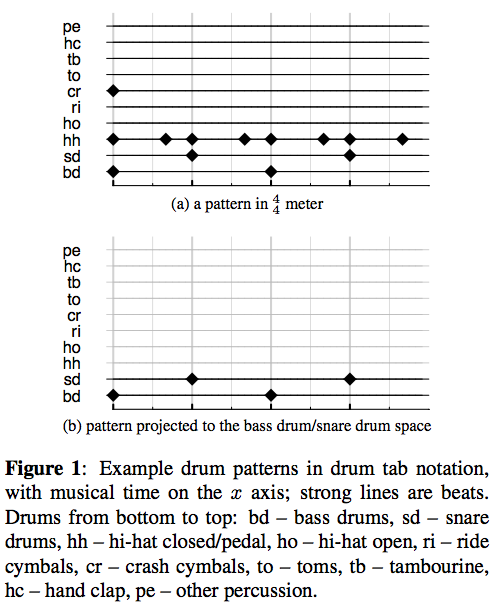ndrum is a project by Matthias Mauch and Simon Dixon at the Centre for Digital Music, Queen Mary, University of London.
This page accompanies our publication A Corpus-based Study of Rhythm Patterns, Matthias Mauch and Simon Dixon, Proceedings of the 13th International Conference on Music Information Retrieval, ISMIR 2012.
PDF preprint
BibTeX.
We investigate the drum patterns present in tens of thousands of MIDI files collected online and derive statistics from them that allow us to get a better picture of the behaviour of the data.
On this page:
ISMIR Pre-Presentation
This a rehearsal presentation of the talk we delivered at ISMIR 2012.
Pattern Definition
A detailed description can be found in the paper, here's an excerpt:
We build reduced drum pattern models by applying five levels of abstraction.

- Bar segmentation. The tracks are segmented into bars. Each bar is a token, the fundamental unit, similar to word tokens in language.
- Drum categorisation. We summarise the drum instruments available in the General MIDI standard into eleven drum categories, such as bass drum, snare drum and crash cymbal, each of which has several instances.
- Tempo abstraction. We discard tempo information (but not metrical structure).
- Intensity abstraction. We discard sound intensity information, i.e. MIDI velocity.
- Quantisation. We quantise the drum notes relative to the beat, reducing the granularity to a grid of 12 equally spaced divisions per beat span, and retain only their onset time.
Statistics
We currently offer a subset of the data produced during the work on the paper.
Corpus statistics
Number of songs: 48,176
Number of bar tokens: 4,765,947
Time signature ranking: here.
We collected 72,283 unique MIDI files from the Internet. In order to understand the nature of the resulting collection, we drew a random sample of 100 songs and manually classified them. The sample mainly contains pop/rock music (62 songs), film music (10), jazz (9), classical (7) and country/folk music (6). Of the six remaining songs, five are of various genres and one was not decodable. A large proportion of the songs are good-quality renditions of popular recordings.
Top 1000 Pattern rankings
- Full drum patterns
Patterns include all drum classes specified in the paper, without any sub-pattern mapping.
ranking of raw counts
ranking of repetition-reduced counts
ranking of song-wise counts - Kick and snare drum patterns
Unlike the full drum patterns, we discard all drums except the kick and snare drums.
ranking of raw counts
ranking of repetition-reduced counts
ranking of song-wise counts - Kick, snare, hihat patterns
Unlike the full drum patterns, we discard all drums except the ones mentioned.
ranking of raw counts
ranking of repetition-reduced counts
ranking of song-wise counts
ranking by collocation score (log likelihood ratio). - Kick, snare, hihat, cymbals patterns
Unlike the full drum patterns, we discard all drums except the ones mentioned.
ranking of raw counts
ranking of repetition-reduced counts
ranking of song-wise counts